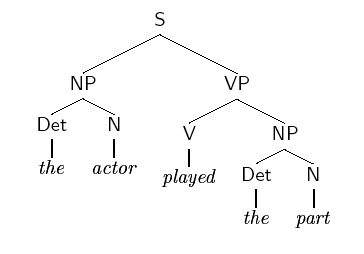Exercise 4.11 (p111)
Pereira and Shieber (1987, pp.178-185) present another kind of bottom-up
parser called a
left-corner parser. Given a structure such as

this parser starts with the terminal ``t
he'' and attempts
to find the structure of which it is the left corner (i.e. the
NP ``
the actor''). It then
attempts to find the structure of which this
NP is the left corner (i.e. the whole
sentence). In parsing the
VP it again starts
with its left-most terminal (
played'') and finds the structure of which
this is the left corner.
The code for the parser (based on that in
Pereira and Shieber) is:
parse(Phrase, S0, S):-
leaf(SubPhrase, S0, S1),
lc(SubPhrase, Phrase, S1, S).
leaf(Phrase, [Word | S], S):-
(Phrase ===> [Word]).
lc(Phrase, Phrase, S, S).
lc(SubPhrase, SuperPhrase, S0, S):-
(Phrase ---> [SubPhrase|Rest]),
parse_rest(Rest, S0, S1),
lc(Phrase, SuperPhrase, S1, S).
parse_rest([], S, S).
parse_rest([Phrase|Phrases], S0, S):-
parse(Phrase, S0, S1),
parse_rest(Phrases, S1, S).
The parser is run with the a call
such as
?- parse(s, [toby,drinks,scotch], []).
Load the program,
together with any BH-GRN grammar and lexicon and trace its
execution.
Partially execute the parser on a grammar to produce a
compiled version.
HINT:
leaf/3 is the counterpart of
shift/4 in the shift-reduce parser.
Its compiled version should therefore be similar to the compiled version
of
shift/4. In the shift-reduce
parser, compilation of the reduction operation results in a call to
parse/4 which the first argument of the head
of the clause matches a list of daughters and the the first argument of the body
matches the mother. With the left-corner parser, the head of the compiled
version of
lc/4 will contain the left
daughter of a rule, the clauses of the body will then parse the remaining
daughters (see program 4.10 for ideas on how to do this) and will conclude with
another call to
lc/4 for the mother of the
grammar rule.
